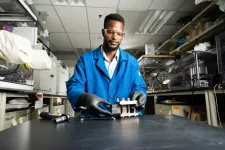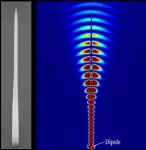(Press-News.org) RICHLAND, Wash.— A commonplace chemical used in water treatment facilities has been repurposed for large-scale energy storage in a new battery design by researchers at the Department of Energy’s Pacific Northwest National Laboratory. The design provides a pathway to a safe, economical, water-based, flow battery made with Earth-abundant materials. It provides another pathway in the quest to incorporate intermittent energy sources such as wind and solar energy into the nation’s electric grid.
The researchers report in Nature Communications that their lab-scale, iron-based battery exhibited remarkable cycling stability over one thousand consecutive charging cycles, while maintaining 98.7 percent of its maximum capacity. For comparison, previous studies of similar iron-based batteries reported degradation of the charge capacity two orders of magnitude higher, over fewer charging cycles.
Iron-based flow batteries designed for large-scale energy storage have been around since the 1980s, and some are now commercially available. What makes this battery different is that it stores energy in a unique liquid chemical formula that combines charged iron with a neutral-pH phosphate-based liquid electrolyte, or energy carrier. Crucially, the chemical, called nitrogenous triphosphonate, nitrilotri-methylphosphonic acid or NTMPA, is commercially available in industrial quantities because it is typically used to inhibit corrosion in water treatment plants.
Phosphonates, including NTMPA, are a broad chemical family based on the element phosphorus. Many phosphonates dissolve well in water and are nontoxic chemicals used in fertilizers and detergents, among other uses.
“We were looking for an electrolyte that could bind and store charged iron in a liquid complex at room temperature and mild operating conditions with neutral pH,” said senior author Guosheng Li, a senior scientist at PNNL who leads materials development for rechargeable energy storage devices. “We are motivated to develop battery materials that are Earth-abundant and can be sourced domestically.”
What is a flow battery?
As their name suggests, flow batteries consist of two chambers, each filled with a different liquid. The batteries charge through an electrochemical reaction and store energy in chemical bonds. When connected to an external circuit, they release that energy, which can power electrical devices. Unlike other conventional batteries, flow batteries feature two external supply tanks of liquid constantly circulating through them to supply the electrolyte, serving as the battery system’s “blood supply.” The larger the electrolyte supply tank, the more energy the flow battery can store.
Flow batteries can serve as backup generators for the electric grid. Flow batteries are one of the key pillars of a decarbonization strategy to store energy from renewable energy resources. Their advantage is that they can be built at any scale, from the lab-bench scale, as in the PNNL study, to the size of a city block.
In the near term, grid operators are looking to locate battery energy storage systems (BESS) in urban or suburban areas near energy consumers. Often, city planners must grapple with consumer safety concerns. The type of aqueous flow battery reported here could help alleviate safety concerns.
[Learn more about how communities grapple with BESS siting.]
“A BESS facility using the chemistry similar to what we have developed here would have the advantage of operating in water at neutral pH,” said Aaron Hollas, a study author and team leader in PNNL’s Battery Materials and Systems Group. “In addition, our system uses commercially available reagents that haven’t been previously investigated for use in flow batteries.”
The research team reported that their initial design can reach energy density, a key design feature, up to 9 watt-hours per liter (Wh/L). In comparison, commercialized vanadium-based systems are more than twice as energy dense, at 25 Wh/L. Higher energy density batteries can store more energy in a smaller square footage, but a system built with Earth-abundant materials could be scaled to provide the same energy output.
Future development of aqueous redox flow batteries
“Our next step is to improve battery performance by focusing on aspects such as voltage output and electrolyte concentration, which will help to increase the energy density,” said Li. “Our voltage output is lower than the typical vanadium flow battery output. We are working on ways to improve that.”
PNNL researchers plan to scale-up this and other new battery technologies at a new facility called the Grid Storage Launchpad (GSL) opening at PNNL in 2024. The GSL, funded by the Department of Energy’s Office of Electricity, which also funded the current study, will help accelerate the development of future flow battery technology and strategies so that new energy storage systems can be deployed safely.
Study contributors included co-lead authors Gabriel S. Nambafu and Hollas, as well as Peter S. Rice, Daria Boglaienko, John L. Fulton, Miller Li, Qian Huang, David M. Reed, Vincent L. Sprenkle, and G. Li from PNNL. Shuyuan Zhang and Yu Zhu from the University of Akron in Akron, Ohio, also participated in the research.
END
New all-liquid iron flow battery for grid energy storage
A new recipe provides a pathway to a safe, economical, water-based, flow battery made with Earth-abundant materials
2024-03-25
ELSE PRESS RELEASES FROM THIS DATE:
Gene discovery offers new hope for people living with chronic skin disease
2024-03-25
Scientists from The Australian National University (ANU) have discovered a gene mutation is responsible for causing psoriasis – a chronic inflammatory skin disease that causes patients to develop red, scaly and itchy patches across their body.
According to ANU researcher Dr Chelisa Cardinez, if two copies of this mutated gene (known as IKBKB) are present, patients with psoriasis may go on to develop psoriatic arthritis, leaving them with joint pain, stiffness and swelling. Thanks to the world-first discovery from ANU, scientists now know what causes the progression from a skin-only disease to a skin and joint disease.
It’s hoped the findings will lead ...
What factors contribute to differences in cervical cancer screening in rural and urban community health centers?
2024-03-25
In the United States, community health centers (CHCs) mainly serve historically marginalized populations. New research reveals that both before and during the COVID-19 pandemic, females receiving care at rural CHCs were less likely to be up to date with cervical cancer screening than those in urban CHCs. Factors associated with these differences included the proportion of patients with limited English proficiency and low income, as well as area-level unemployment and primary care physician density. The findings are ...
2 in 3 parents say their adolescent or teen worries about how sick days may impact grades
2024-03-25
ANN ARBOR, Mich. – Many parents struggle deciding whether their middle or high school aged child should stay home from school if they don’t feel well, a new national poll suggests.
Among top factors: how their adolescent or teen is behaving due to symptoms and if they can get through a school day, the risk that they’re contagious and whether the student will miss a test, presentation or after school activity.
One in five parents also consider if their child needs a mental health day, according to the University of Michigan ...
Physician work hours, especially for male doctors, have declined since 1987
2024-03-25
Physicians in Canada, especially male physicians, are working fewer hours than they did 3 decades ago, and these long-term trends must be considered in workforce planning, according to new research in CMAJ (Canadian Medical Association Journal) https://www.cmaj.ca/lookup/doi/10.1503/cmaj.231166.
"Canadian physicians' work hours, crucial for health care access and planning, have seen a long-term decline, especially among male and married physicians, suggesting a shift towards better work–life balance," said Dr. Boris Kralj, Department of Economics, Centre for Health Economics & Policy Analysis, McMaster University, Hamilton, Ontario.
Using ...
RaDPi-U: A fast and convenient drug screening with urine samples
2024-03-25
Drugs, both legal and illegal, cause millions of cases of severe intoxication every year, leading to health complications and even fatalities. Often, they are also implicated in violent and sexual harassment crimes, as well as accidents. Obtaining detailed information about the drugs consumed by a criminal or victim is often challenging. Forensic professionals rely on drug screening techniques performed on biological samples, such as blood or saliva, to gather crucial evidence.
Today, various types of practical drug screening methods exist, each with their own unique advantages ...
Sweeping review reveals latest evidence on the diagnosis, treatment, and monitoring of ADHD
2024-03-25
Hundreds of studies are published each year on attention deficit hyperactivity disorder (ADHD), but more work is needed to ensure those findings improve lives.
With input from expert stakeholders across the field, researchers at the Southern California Evidence Review Center, part of the Keck School of Medicine of USC, have synthesized the latest insights so that they can ultimately inform clinical practice. Broadly, they found that both medications and psychosocial treatments work for treating ADHD and that children with the condition can and do get better.
“We have more research than ever on ADHD, but we need ...
The world is one step closer to secure quantum communication on a global scale
2024-03-25
Researchers at the University of Waterloo's Institute for Quantum Computing (IQC) have brought together two Nobel prize-winning research concepts to advance the field of quantum communication.
Scientists can now efficiently produce nearly perfect entangled photon pairs from quantum dot sources.
Entangled photons are particles of light that remain connected, even across large distances, and the 2022 Nobel Prize in Physics recognized experiments on this topic. Combining entanglement with quantum dots, a technology recognized with the Nobel Prize in Chemistry in 2023, the IQC research team aimed to optimize the ...
Political beliefs shape the way the public interprets history
2024-03-25
By exploring attitudes in the USA, UK, Italy, South Africa, Mexico, and Poland – countries with different economies, cultures and political regimes (past and present) – the paper shows that, in all countries, right- compared to left-wing supporters evaluated the past more positively.
The data reveal that, in part, this occurs because right-wing supporters are more nostalgic about tradition. While the right looked more favourably to the past, in the USA and Poland (and potentially in the UK too), the left was more ...
Researchers carry out first peer-reviewed study of fecal microbiota transplants in dolphins
2024-03-25
Scientists have successfully carried out pioneering fecal microbiota transplantations on Navy bottlenose dolphins that showed signs of gastrointestinal disease.
One dolphin in particular who was outwardly ill was able to be taken off medication during the treatment course, with his appetite and energy returning to normal, according to the team at the National Marine Mammal Foundation.
The project was carried out jointly between the NMMF, the U.S. Navy Marine Mammal Program and the Gilbert Lab at UCSD School of Medicine and Scripps Institution of Oceanography, and its findings were published in the Journal of ...
African catfish skin mucus yields promising antibacterial compound
2024-03-24
Scientists report they have extracted a compound with powerful antibacterial properties from the skin of farmed African catfish. Although additional testing is necessary to prove the compound is safe and effective for use as future antibiotic, the researchers say it could one day represent a potent new tool against antimicrobial-resistant bacteria such as extended-spectrum beta-lactamase (ESBL) producing E. coli.
Hedmon Okella is a postdoctoral researcher at the University of California, Davis, and led the project.
“The global public health threat due to antimicrobial resistance ...
LAST 30 PRESS RELEASES:
Electrodes created using light
Second-hand gift-giving is a well-deliberated decision
How human interaction drove evolution to make bears less aggressive
National Poll: Few parents offer teens guidance on healthy eating during holiday season
Cannabis derivatives could provide new ovarian cancer treatments
Raising strong yeast as a petroleum substitute
Clues to the origin of hot Jupiters hidden in their orbits
Canada’s reduced pledge to Global Fund will impact domestic health
1 in 4 children with major traumatic injuries not cared for in pediatric trauma centres
Duke and Duke-NUS’ joint cross-population research to uncover "East-West" differences in disease and care
Scientists to ‘spy’ on cancer- immune cell interactions using quantum technology breakthrough
Tech savvy users have most digital concerns
Making lighter work of calculating fluid and heat flow
Normalizing blood sugar can halve heart attack risk
Lowering blood sugar cuts heart attack risk in people with prediabetes
Study links genetic variants to risk of blinding eye disease in premature infants
Non-opioid ‘pain sponge’ therapy halts cartilage degeneration and relieves chronic pain
AI can pick up cultural values by mimicking how kids learn
China’s ecological redlines offer fast track to 30 x 30 global conservation goal
Invisible indoor threats: emerging household contaminants and their growing risks to human health
Adding antibody treatment to chemo boosts outcomes for children with rare cancer
Germline pathogenic variants among women without a history of breast cancer
Tanning beds triple melanoma risk, potentially causing broad DNA damage
Unique bond identified as key to viral infection speed
Indoor tanning makes youthful skin much older on a genetic level
Mouse model sheds new light on the causes and potential solutions to human GI problems linked to muscular dystrophy
The Journal of Nuclear Medicine ahead-of-print tip sheet: December 12, 2025
Smarter tools for peering into the microscopic world
Applications open for funding to conduct research in the Kinsey Institute archives
Global measure underestimates the severity of food insecurity
[Press-News.org] New all-liquid iron flow battery for grid energy storageA new recipe provides a pathway to a safe, economical, water-based, flow battery made with Earth-abundant materials







